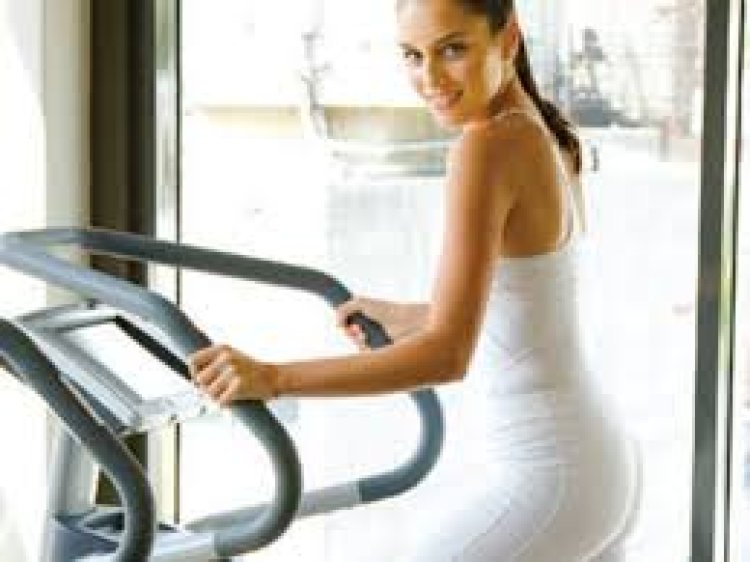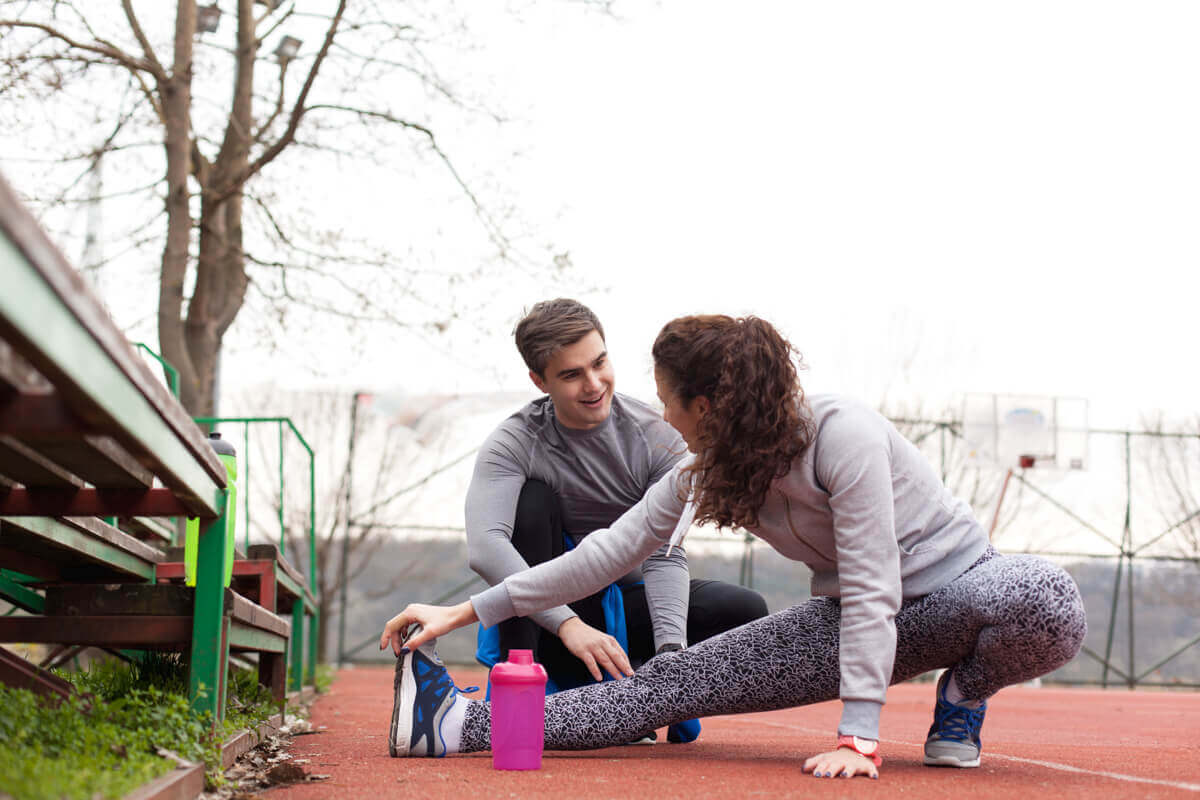The cornerstone of every fitness regimen should be aerobic exercise, and for good reason. The American Heart Association recommends doing cardio, or cardiovascular exercise, because it raises your heart rate and breathing rate, so improving your cardiorespiratory fitness.
According to the Physical Activity Guidelines, aerobic exercise consists of things like brisk walking, jogging, cycling, swimming, aerobic fitness classes (including kickboxing), tennis, dance, yard work, tennis, and jumping rope.
As you get older, strength exercise is essential for maintaining and enhancing your mobility and quality of life. "Losing muscle mass as you become older can have a major effect on your quality of life. According to Robert Sallis, MD, family medicine doctor at Kaiser Permanente in Fontana, California, and chairman of the Exercise Is Medicine initiative with the American College of Sports Medicine (ACSM), "strength exercises build bones and muscle, and more muscle protects your body from falls and the fractures that can happen in older age."
The American College of Sports Medicine (ACSM) describes strength training as any physical activity "designed to improve muscular fitness by exercising a muscle or a muscle group against external resistance." According to the HHS Physical Activity Guidelines, activities like weightlifting, using resistance bands or your own body weight, carrying heavy items, and even severe gardening can help.
The International Society of Sports Nutrition cites flexibility and mobility as two hallmarks of good activity. They are, however, not interchangeable.
Mobility is the ability to move a joint through its full range of motion, whereas flexibility is the ability of the body's tendons, muscles, and ligaments to stretch.
According to the HHS Physical Activity Guidelines, there is no recommended amount of time spent on activities that increase flexibility or mobility (such as stretching), and the health benefits of these activities are unknown due to a lack of research on the topic. However, the guidelines stress the significance of flexibility training for overall health and well-being.
Older persons are encouraged to make balance training a regular part of their exercise routine, as is suggested by the guidelines. The risk of falls, which can lead to catastrophic and disabling injuries, can be greatly reduced by engaging in regular exercise that includes balance training, according to the available evidence.
Health Benefits of Exercise
Long-term illnesses including heart disease, type 2 diabetes, and cancer can be avoided with greater fitness. Fitness, says Grayson Wickham, DPT, CSCS, founder of New York City's Movement Vault, a mobility and movement company, is the single most important factor in preventing practically any condition.
To make physical activity evaluation a standard aspect of medical care and to make exercise accessible to people of all abilities, ACSM and the American Medical Association launched the Exercise Is Medicine campaign in 2007. According to the initiative's website, "the scientifically proven benefits of physical activity remain indisputable," and "they can be as powerful as any pharmaceutical agent" in preventing and treating a variety of chronic diseases and medical problems.
Exercise Boosts Your Mood
Exercising regularly has been demonstrated to protect against mental health issues like sadness and anxiety. Furthermore, a research article emphasizes that exercise can aid in the management and treatment of depression. Physical activity may generate positive changes in the brain, and it may also assist lower inflammation, both of which are known to be elevated in depressed individuals.
Exercise Is Good for Sleep
Regular exercise can improve the quality of your nightly rest. Among the 34 research considered for this meta-analysis, 29 concluded that physical activity led to better sleep and longer sleep durations. Past study has shown that it can alleviate presleep anxiety that may otherwise keep you up, and it may help establish your body clock (so that you are aware and drowsy at appropriate times).
High-intensity exercise is beneficial, but it's important to note that doing it too close to night (within an hour or two) can make it harder for some individuals to sleep, so it's best to do it earlier in the day.
Exercise Promotes Long-Term Health
Exercising regularly provides various health benefits, including a lower risk of several diseases (including cancer and stroke), better digestive health, increased libido, and enhanced sex life. Getting the recommended 150 to 300 minutes of exercise each week was also shown to reduce the risk of death from any cause by 19 percent in a study including more than 116,000 adults.
Fitness Helps You Manage Chronic Disease
Managing various chronic health conditions is one of the many benefits of exercise on overall bodily function. The Centers for Disease Control and Prevention (CDC) state that regular physical activity is beneficial for those who suffer from osteoarthritis, high blood pressure, type 2 diabetes, multiple sclerosis, Parkinson's disease, dementia, or who have suffered a stroke or cancer. Physical activity has been linked to a variety of health benefits, including reduced pain, better insulin sensitivity and blood sugar control, increased mobility, enhanced heart health, reduced risk of various chronic diseases, and contributions to emotional well-being.
Maintaining or increasing your level of physical activity while living with a chronic condition is best accomplished by walking. According to Sallis, "the vast majority of people do not need clearance from their doctor to start walking," provided that no doctor has expressly advised against exercise.
He says, "You need to get clearance from your doctor not to exercise," and he wants more individuals will use physical activity as a baseline.
However, you should seek medical attention if you notice that you are becoming increasingly breathless, have chest pain, or experience any other unusual symptoms.
How Much Exercise Do You Need?
Managing various chronic health conditions is one of the many benefits of exercise on overall bodily function. The minimum amount of exercise that promotes good health is 150 minutes of moderate-intensity aerobic activity (such as brisk walking) or 75 minutes of vigorous-intensity aerobic activity (such as jogging or running), as stated by the Centers for Disease Control and Prevention (CDC) and the U.S. Department of Health and Human Services' Physical Activity Guidelines for Americans. (It's fine to do a mix of moderate and severe exercise as long as you do it on at least two separate days.)
In addition, the guidelines recommend engaging in muscle-strengthening activities at least twice weekly, with the exercises focusing on all of the major muscle groups (the legs, hips, back, belly, chest, shoulders, and arms).
The HHS makes no recommendations on flexible or mobile employment at this time. However, older persons, in particular, should make balance training a regular part of their exercise routine.
In particular, up to 300 minutes of moderate-intensity exercise per week (beyond which the incremental advantages start to flatten off), increased physical activity has been related to even larger health benefits. Keep in mind that while these general fitness guidelines will help you live a long and healthy life, they may not be enough to help you achieve your specific fitness or health objectives. (If you want to train for a marathon, for instance, you'll need to put in a lot more time at the gym every week.)
And keep in mind that overdoing it on the exercise front can have unintended consequences; scientists are still trying to pin down just how much exercise is too much, but preliminary evidence suggests it's at least several times the weekly minimum recommendations.You can benefit from exercise if you have osteoarthritis, hypertension, diabetes type 2, multiple sclerosis, Parkinson's disease, dementia, a history of stroke or cancer. Physical activity has been linked to a variety of health benefits, including reduced pain, better insulin sensitivity and blood sugar control, increased mobility, enhanced heart health, reduced risk of various chronic diseases, and contributions to emotional well-being.
Maintaining or increasing your level of physical activity while living with a chronic condition is best accomplished by walking. According to Sallis, "the vast majority of people do not need clearance from their doctor to start walking," provided that no doctor has expressly advised against exercise.
He says, "You need to get clearance from your doctor not to exercise," and he wants more individuals will use physical activity as a baseline.
However, you should seek medical attention if you notice that you are becoming increasingly breathless, have chest pain, or experience any other unusual symptoms.
What to Eat Before, During, and After Exercise
An integral part of doing out is making sure your body is getting the proper fuel.
Before Your Workout
Jackie Dikos, RDN, a sports dietitian in Westfield, Indiana and author of Finish Line Fueling, recommends paying attention to hunger cues if you exercise first thing in the morning. You could not be hungry if the previous night's dinner was particularly hearty or if it was served late. And if you have Jackie Dikos, RDN, a sports dietitian in Westfield, Indiana and author of Finish Line Fueling, recommends paying attention to hunger cues if you exercise first thing in the morning. You could not be hungry if the previous night's dinner was particularly hearty or if it was served late. You may want to get a bite to eat before you to the gym if you're feeling peckish.
Eating a banana or some cereal 30 minutes before an exercise, or a combination of carbs and protein (such toast with nut butter), can provide you with the energy you need to get through the session. You may not need the snack at all if you just ate.if you have a strenuous workout planned and are feeling peckish.
Eating a banana or some cereal 30 minutes before an exercise, or a combination of carbs and protein (such toast with nut butter), can provide you with the energy you need to get through the session. You may not need the snack at all if you just ate.
During Your Workout
When You're Working Out Mid-workout feeding isn't necessary for shorter sessions, but it is necessary for prolonged bouts of endurance exercise. After the first 60 minutes of exercise, the International Society of Sports Nutrition recommends consuming 30-60 grams of carbs every hour. To that end, there are sports drinks.
After Your Workout
Following Your Workout According to Dikos, you don't need to replenish right after a 45-minute brisk stroll or other low- to moderate-intensity workout (especially if your next meal isn't too far away). However, your body will require nourishment if you have just finished a high-intensity activity, if you plan on performing another workout later that day, or if you plan on completing a rigorous session the following day. Dikos suggests consuming 10–20 grams of protein and 0.5 grams of carbohydrates per pound of body weight.















